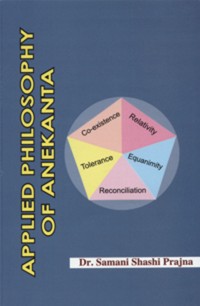From 17th cent. up to Modern Age 2010
Navya Nyāya period of Logic begins with the Gangeśa Upādhyāya (17th cent. CE). He gave birth to Navya Nyaya method. From that period onwards, all the philosophers rechecked their view in the context of Navya Nyāya method. But it is a matter of misfortune that no Jaina Ācārya before Yaśovijaya (1624-1688 cent. CE) looked upon this new method. Yaśovijaya, a man of extra-ordinary talent went to Kāśī for scriptural study and came back as a pandita of Indian philosophy. He then wrote more than one hundred works. He wrote Jain texts also in the light of Navya Nyāya method and tried to reply to the 'non-Jain philosophers' refutations, against anekānta. He wrote 'anekānta vyavastha' and re-established this philosophy of anekānta. He wrote Aṣta Sahasrī and Sāstravārtā Sammurcaya's commentary in a new logic method and made both the old texts as modern. He wrote Jaina Tarka-Bhāṣā, Gyān-Biṇdu to enrich the treasure of Pramāṇa literature. Nayavāda is the basis of anekānta and on that he wrote Naya Pradīpa, Naya Rahasya, Nayopadeśa etc. In this period Vimaldāsa wrote, Saptabhangī Tarangini in the Navya Nyaya style to logically establish the theory of (15th cent. CE) syādvāda and anekānta.
After this, in the eighteenth century, there begins the period of transition and decline in Jaina philosophy. When we try to trace out the history of anekānta, the eighteen century and nineteenth century can be compared with the search of trees in the barren land in the absence of any work written on anekānta.
In the Modern age also Jaina scholars wrote many texts highlighting anekānta both in Hindi and in English Language. Although in this age, philosophers don't have to face any objections, still quite often the scholars are misled due to insufficient knowledge of the anekānta. Even Śaṃkarāchārya and Dr. Sarvapalli Radhakrishnan considered syādvāda as probability or doubtful or indecisive doctrine. To remove such misconception or misunderstanding regarding the theory of anekānta Satkari Mukherjee wrote a comprehensive book named 'Non-absolutism'. B.K. Matilal wrote 'The Central Philosophy of Jainism: Anekāntavāda'. Dalsukha Malvaniyaji wrote 'Āgam Yuga ka Jaina Darśan’ in which, he tried to trace-out the origin and development of anekānta after prolonged research. In this age, Sagarmal Jain also wrote books on anekānta and syādvād. Then Ācārya Tulsi (20th cent. CE) wrote Jaina Siddhānta Dīpikā, (translated as Illuminator of Jaina Tenets) and 'Bhikṣu Nyāya Karṇikā' in which he elaborately discussed about syādvāda, nayāvāda in a very lucid Saṃskṛta language. Ācārya Mahāprajña (1920-2010 CE) wrote a series of books on anekānta and showed its relevance in the world of affairs. His works are namely, 'Anekānta: The Third Eye', 'The Quest for Truth', 'Anekānta: Reflections And Clarifications', 'Anekānta: Views and Issues', 'Jaina Darśana: Manan Aur Mīmāmsā', 'New Dimensions in Jaina Logic', 'Jaina Darśana Aur Anekānta', 'Ekānta Mein Anekānta: Anekānta Mein Ekānta', 'Anekānta: Philosophy of Co-existence’, etc.
These are considered research oriented books, wherein we can perceive the depth of Jain philosophical concepts. The speciality of his writing is that, he writes practical application of anekānta in all the spheres of life. Thus he tried to bring out the anekānta from the world of mere debates to the day-to-day application in life, which is the essence of Mahāvīra's teachings of anekānta.
 Dr. Samani Shashi Pragya
Dr. Samani Shashi Pragya

